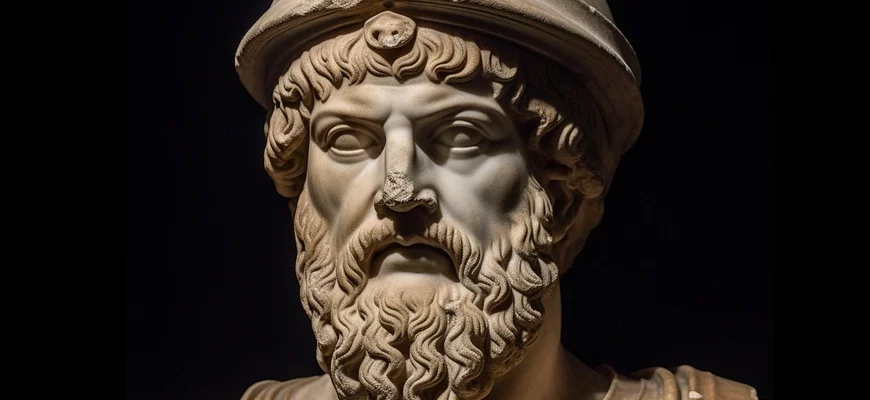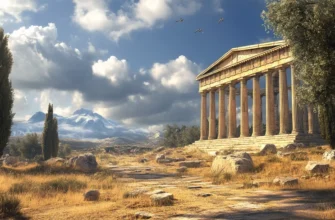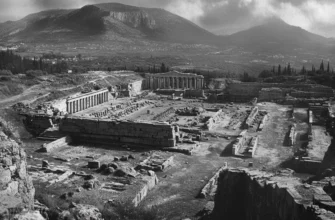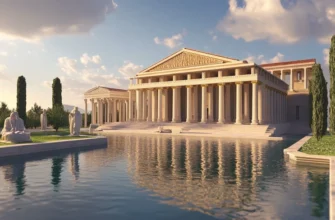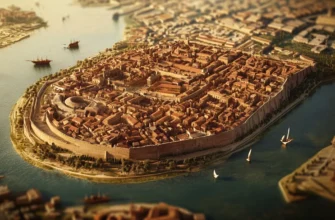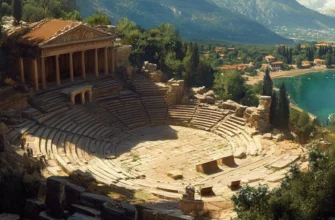The Golden Age of Athens was the period of prosperity of this city in the 5th century BC during the reign of Pericles. During this time, significant political, cultural, and architectural achievements were made. Pericles supported democracy, developed science and philosophy, and raised the level of art and architecture. The Acropolis and the Parthenon became symbols of the era. However, after Pericles’ death, Athens began to decline, which was reflected in the history of Ancient Greece.
- The political context of the Periclean era
- Democracy and Pericles’ strong leadership
- Foreign policy of Athens
- The cultural heyday of Athens during the time of Pericles
- Philosophy and science in Athens
- The Acropolis and the Parthenon
- The legacy of the “Golden Age”: causes and consequences
- Reasons for the decline after Pericles’ death
- Conclusion
The political context of the Periclean era
The Age of Pericles, which spans the second half of the 5th century BC, was one of the most luxurious and prosperous periods in the history of Athens. The political context of this era was defined by democracy, which emerged in Athens in the early 5th century BC. Pericles was one of the leading politicians who helped strengthen democratic rule in Athens. He promoted laws that gave the majority of Athenian citizens the right to vote and introduced salaries for public officials, which made it possible for broad sections of the population to gain access to power. Pericles also helped strengthen Athens’ foreign policy, including through the development of military power and colonization. Overall, the Age of Pericles in Athens was a period of democracy, reform, and foreign expansion.
Democracy and Pericles’ strong leadership
Pericles (495-429 BC) was an outstanding statesman and military leader of Athens in the 5th century BC. He is known for his contribution to the development of Athenian democracy and the creation of a new political system that became an example for other Greek cities.
Pericles was known for his ability to lead people and govern the state. He believed that equality before the law was the fundamental principle of democracy and did everything in his power to ensure that it was upheld. At the same time, he defended the idea that it was better to entrust the government to talented and capable leaders than to the masses.
Thus, Pericles sought to combine democracy with strong leadership. He contributed to the development of Athenian democracy by expanding the rights of citizens, initiating the construction of monumental buildings, and sponsoring artistic projects. At the same time, he was himself a strong leader and upheld the authority of Athens in Greece.
Pericles also pursued a foreign policy that ensured the security and prosperity of Athens. He strengthened the city’s military power and developed maritime trade. His policies contributed to the growth of Athens’ influence in Greece and beyond.
In general, Pericles is known as one of the most prominent figures of antiquity, combining democracy and strong leadership, which allowed Athens to occupy a leading position among Greek cities. During his leadership, Athens enjoyed stability and prosperity, allowing it to become one of the most important states of the time.
However, Pericles was also criticized for his political actions. His opponents disliked his concentration of power in the hands of a few, as well as his spending on monumental buildings, which they considered unnecessary.
Despite the criticism, Pericles left a significant mark on the history of Greece and the world as a whole. His legacy lies in the fact that he created a system of government that combined democracy and strong leadership, which was an important step in the development of political theory and practice.
Foreign policy of Athens
Athens’ foreign policy in the 5th century BC was aimed at increasing its influence and trade links with other Greek cities and states, as well as ensuring the security and defense of its territories.
Under Pericles, Athens strengthened its naval and military power. They participated in wars with other Greek cities and states, such as Sparta, Corinth, and Salamis. The Athenian fleet was one of the largest and strongest in Greece, allowing Athens to ensure the safety and protection of its trade routes and colonies.
One of the most famous wars in which Athens participated was the Peloponnesian War (431-404 BC). This war was a struggle for influence between Athens and its allies against Sparta and its allies. Pericles decided to ban military expeditions to mainland Greece and focus efforts on naval operations. This was a successful decision, as the Athenian fleet played an important role in the battles against the Spartans. However, the war led to the exhaustion and weakening of the Athenian Empire and a decrease in its influence in Greece.
Another important element of Athenian foreign policy was trade relations with other Greek cities and states, as well as with Eastern states, particularly Persia. Athenian merchants and travelers traded with various countries, from Italy to Egypt, which contributed to economic development and cultural exchange.
The Acropolis of Athens, particularly the Parthenon, was also an important symbol of Athens’ power and cultural influence. The architectural and artistic masterpieces created in Athens in the 5th century BC are considered some of the most outstanding achievements of ancient culture.
In general, Athens’ foreign policy in the 5th century BC was successful, as under the leadership of Pericles, the city reached its peak. Athens became the center of Greek culture, science, and art, as well as a major trading and maritime power that influenced events in Greece and beyond.
The cultural heyday of Athens during the time of Pericles
The time of Pericles is considered the golden age of Athenian culture, when the city achieved incredible cultural achievements that remain an example to follow to this day.
Under Pericles’ leadership, architectural masterpieces such as the Parthenon, the Erechtheion, the Propylaea, and the Temple of Olympian Zeus were built. These structures are still considered examples of exquisite beauty, simplicity, and symmetry. Artists also achieved significant success, and Zeus in the Temple of Olympian Zeus became the main symbol of Athenian artistic culture.
During the Periclean era, science and philosophy flourished. Socrates’ student, the philosopher Plato, wrote about his time: “When the great Pericles ruled, the city of Athens was already at the height of its glory in science and art.”
Athenian drama also reached its peak during Pericles’ reign. The genres of tragedy and comedy were created in Athens, and great playwrights such as Aeschylus, Sophocles, and Euripides created masterpieces that remain among the most outstanding achievements of world drama to this day.
In general, the cultural flourishing of Athens during the time of Pericles was unparalleled in the ancient world. It became a model for the further development of culture and art not only in Greece but throughout the world.
Philosophy and science in Athens
Philosophy and science had a great influence on the cultural development of Athens during the time of Pericles. Many outstanding thinkers and scientists lived and worked in Athens, including Socrates, Plato, Aristotle, Eudoxus, and others.
Socrates was known for his dialogues, which marked the beginning of a philosophical methodology known as the Socratic method. His student, Plato, developed the philosophical concept of the theory of ideas, which played a major role in the development of Western philosophy. Aristotle, in turn, was one of the first systematizers of knowledge and is known for his contributions to logic, ethics, and natural sciences.
The first European university school, the Lyceum, was also established in Athens, where outstanding thinkers and scientists, including Archimedes, Euclid, and Hippocrates, studied and taught. The Lyceum was a center of scientific research, and its students made significant contributions to the development of mathematics, physics, astronomy, and medicine.
Overall, Athens during the Periclean era became a center of scientific and philosophical research, marking a new era in the history of science and philosophy. Many of the achievements made in Athens during that period still form the foundation of modern scientific and philosophical research.
The Acropolis and the Parthenon
The Acropolis and the Parthenon are two of the most famous historical monuments in Athens. The Acropolis is a mountain plateau 156 meters high, rising above the city center. This place was of great importance to the inhabitants of Athens, as it was home to many religious, administrative, and military buildings.
One of the most famous structures on the Acropolis is the Parthenon, a temple built in honor of the goddess Athena Parthenos (the Virgin Mary). The Parthenon was built during the time of Pericles in the 5th century BC and is an example of ancient Greek architecture. It was the largest temple on the Acropolis and one of the most famous monuments in world history.
The Parthenon was built on a high marble base and consisted of 46 columns and two porticoes. It was decorated with sculptures, including famous metopes depicting scenes from Greek mythology and battles between Amazons and Athenian warriors.
Over time, the Parthenon fell into ruin due to a series of wars and natural disasters that caused significant damage. However, restoration work is currently underway to preserve this historic building for future generations.
All these monuments are important not only for the history of Athens but also for the whole world as examples of sophisticated ancient Greek architecture and art.
In addition to the Parthenon, many other architectural masterpieces were built in Athens during the time of Pericles.
One of the most famous is the Erechtheion, built in the northwest of the Acropolis. This temple, commissioned by Pericles, had a sophisticated architecture and was decorated with caryatids—sculptural figures of women that served as columns.
Another important temple is the Temple of Olympian Zeus, which was the largest temple in Greece at the time. It was built in the 5th century BC and decorated with sculptures and paintings.
In addition to temples, Pericles also paid attention to the development of the city and the construction of other buildings. For example, he commissioned the construction of the Pantheon, a place where the relics of Greek heroes were kept. He also initiated the construction of several theaters, including the Theater of Dionysus, which was famous for its productions of tragedies.
All these structures are evidence of the creative potential and talent of the Athenian architects and craftsmen of that time. They reflect the refined ancient Greek architecture and art, which remain a source of inspiration for art around the world to this day.
The legacy of the “Golden Age”: causes and consequences
The legacy of the Golden Age of Athens came in the next generation after Pericles and was caused by several factors.
One of the main reasons was the Peloponnesian War, which lasted almost 30 years, from 431 to 404 BC. This war was fought between Athens and its allies against Sparta and its allies. As a result of this conflict, the city suffered significant losses, including not only the loss of human lives and the cost of the military campaign, but also the destruction and damage of important buildings and infrastructure.
The second reason was the plague epidemic that broke out in Athens in 430 BC and claimed the lives of many people, including Pericles himself.
The third reason was the growing influence of other Greek city-states, particularly Sparta, and Athens’ loss of its monopoly in trade and maritime affairs.
The consequences of the decline of the “Golden Age” for Athens were significant. The loss of its position as a metropolis and its overall influence on the Greek world led to a decline in prosperity and a reduction in the city’s role in political affairs. In addition, the cultural, scientific, and artistic revival that had characterized the “Golden Age” came to an end. Nevertheless, the decline of the Golden Age did not mean the complete destruction of Athens—the city continued to exist and develop, albeit with less influence on the Greek world.
Reasons for the decline after Pericles’ death
After Pericles’ death, Athens faced significant difficulties and the legacy of the Golden Age. The main reasons for this decline can be considered as follows:
Political conflicts: Pericles supported democracy and was a master of political manipulation, which allowed him to maintain control over the city. After his death, the political situation in Athens became less stable, leading to conflicts and power struggles between different factions.
Wars: The wars with the Peloponnese and other Greek states that followed Pericles’ death caused significant losses for Athens, including the loss of territory and a large number of the city’s inhabitants.
Epidemics: The plague epidemic that broke out in 430 BC claimed the lives of Pericles and many other inhabitants of the city. Other epidemics that broke out in the following years also led to the loss of human lives and a decline in the city’s economic development.
Economic difficulties: The period after Pericles’ death led to a decline in trade and craftsmanship in the city, which affected Athens’ economy. The decline in trade and craftsmanship led to a decrease in income and a reduction in Athens’ ability to finance its military and infrastructure projects.
As a result of the decline of the “Golden Age,” the city lost its influential role in Greece and was forced to reduce its military and infrastructure projects. In the period after Pericles’ death, Athens lost its cultural and scientific leadership, which led to a decline in intellectual activity and innovation in the city. Many Athenian thinkers and scholars moved to other states, such as Sparta, Miletus, or Chios, leading to a loss of talented individuals in the city.
Overall, after Pericles’ death, Athens faced significant difficulties that led to the decline of the Golden Age and the city’s loss of influence in Greece. However, the decline of the “Golden Age” was not entirely destructive, as the city later managed to recover and become an important cultural and intellectual center in the second half of the 4th century BC.
Conclusion
Golden Age of Athens during the time of Pericles was one of the most prosperous and culturally and intellectually developed periods in the history of Athens and Greece as a whole. During Pericles’ reign, the city reached the heights of success as a political and cultural center, becoming the birthplace of democracy and the development of philosophy, science, and art.
During this period, Athens became a model of a democratic state, where every citizen had the opportunity to participate in political life and make important decisions. The cultural flourishing of Athens during Pericles’ reign was unprecedented and included such remarkable phenomena as architectural masterpieces (the Parthenon, the Erechtheion, and others), poetry, drama, philosophy, and science.
Although Pericles died in 429 BC, Athens’ success continued for some time. However, after Pericles’ death, the city faced significant difficulties that led to the decline of the “Golden Age” and the loss of the city’s influence in Greece. Nevertheless, the Age of Pericles remains one of the most significant periods in the history of Athens and Greece as a whole, influencing the development of democracy, science, culture, and art throughout the world.
